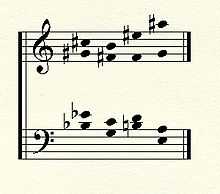Vingt regards sur l'enfant-Jésus
Vingt regards sur l'enfant-Jésus is a collection of 20 pieces by the French composer Olivier Messiaen (1908–92) for solo piano. The work is a meditation on the childhood of Jesus, lasting around two hours in performance. The French title translates roughly as "Twenty contemplations on the infant Jesus". It was composed in 1944 for Yvonne Loriod, whom Messiaen married in 1961, after the death of his first wife.
Movements
There are 20 movements:
- Regard du Père ("Contemplation of the Father")
- Regard de l'étoile ("Contemplation of the star")
- L'échange ("The exchange")
- Regard de la Vierge ("Contemplation of the Virgin")
- Regard du Fils sur le Fils ("Contemplation of the Son upon the Son")
- Par Lui tout a été fait ("Through Him everything was made")
- Regard de la Croix ("Contemplation of the Cross")
- Regard des hauteurs ("Contemplation of the heights")
- Regard du temps ("Contemplation of time")
- Regard de l'Esprit de joie ("Contemplation of the joyful Spirit")
- Première communion de la Vierge ("The Virgin's first communion")
- La parole toute-puissante ("The all-powerful word")
- Noël ("Christmas")
- Regard des Anges ("Contemplation of the Angels")
- Le baiser de l'Enfant-Jésus ("The kiss of the Infant Jesus")
- Regard des prophètes, des bergers et des Mages ("Contemplation of the prophets, the shepherds and the Magi")
- Regard du silence ("Contemplation of silence")
- Regard de l'Onction terrible ("Contemplation of the awesome Anointing")
- Je dors, mais mon cœur veille ("I sleep, but my heart keeps watch")
- Regard de l'Eglise d'amour ("Contemplation of the Church of love")
Thèmes



Messiaen uses Thèmes or leitmotifs, recurring elements that represent certain ideas. They include:
- Thème de Dieu ("Theme of God")
- Thème de l'étoile et de la croix ("Theme of the Star and of the Cross")
- Thème de l'amour mystique ("Theme of Mystical Love")
- Thème d'accords ("Theme of Chords")
- Thème de danse orientale et plain chantesque ("Theme of Oriental Dance and Plainsong")- Prominent in Regard de l'Esprit de joie.
- Thème de joie ("Theme of Joy")
- 1er Thème ("1st Theme", a motif in the final movement highlighted by the composer's analysis)
Movement 18, "Regard de l’onction terrible", is an example of how Messiaen used his ideas on form and symmetry in his compositions.
The piece starts with the right hand descending on a chromatic scale and in tritone chords. After the opening semi-quavers, the durations of the notes start to elongate, first to quavers then to dotted quavers, quavers, crotchets, dotted crotchets, minims, dotted minims and finally a semibreve. While this is happening in the right hand, the left hand is doing the same but in reverse, starting with the semibreve and working towards the semiquavers.
As the main subject of the movement is reached, a chorale is heard; but in keeping with Messiaen’s strict formal design, it is rendered in bare octaves and fifths. After the chorale is repeated, the movement proceeds to two variations of sections from within the chorale before the full melody is heard again, this time transposed up a major 3rd.
This variation and repeat of the chorale in different keys continues until another return to the opening theme; however, this time the left hand plays the slowing, descending passage, while the right plays the ascending, accelerating passage – their roles reversed. The form for this movement can be analysed as: X–A–A–B–A–C–A–B–A–A–C–X.
| ||||||||||